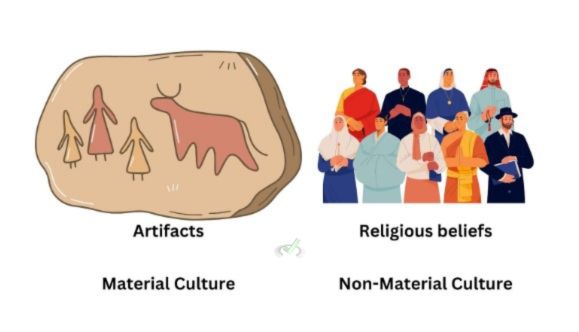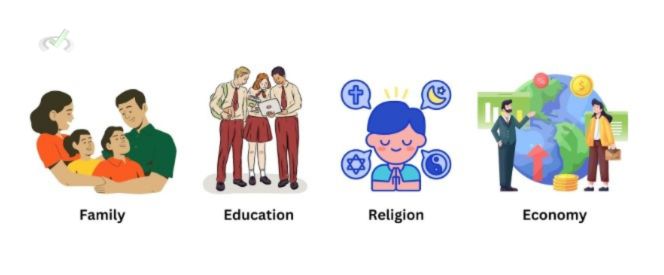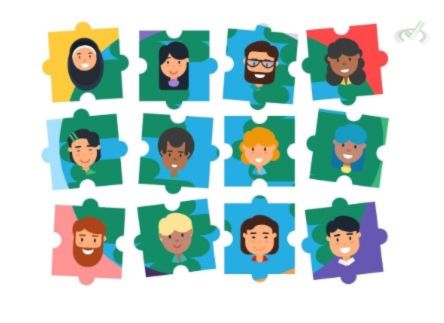When you attend a festival, follow a family tradition, or even just greet someone. Culture shapes how societies function and how people interact with each other. Understanding culture is essential in sociology because it influences behavior, social structures, and relationships. Let's explore the significance of culture in sociology.
I. Introduction to Culture in Sociology
Culture refers to the shared practices, beliefs, values, and artifacts that members of a society use to interact with their world and each other. These elements influence everything from daily interactions to the organization of social institutions.
Key Concepts
- Norms: These are the rules and expectations which a society guides the behavior of its members. Norms can be formal, like laws, or informal, like customs.
- Values: These are deeply held beliefs about what is good, right, and desirable in a society. Values guide how people behave and make decisions.
- Symbols: Anything that carries a particular meaning recognized by people who share a culture. Symbols can be gestures, signs, objects, signals, and words.
II. Components of Culture
Culture is made up of several vital components that work together to shape societies:
Language
Language is a system of symbols. It allows people to communicate with each other.
It is crucial because it facilitates everyday interaction and the transmission of culture from one generation to the next. For example, stories and traditions are passed down through language.

Beliefs
Beliefs are specific ideas that people hold to be true. They shape how individuals perceive the world and behave within it.
For example, some cultures believe in the importance of community over the individual, while others prioritize individualism. This belief influences how people make decisions and interact with each other.

Material Culture
This includes the physical objects that people create and use. Examples include buildings, artwork, tools, and technology.
These artifacts are essential for understanding a society's way of life and values. For example, the design of a building can reflect cultural values in terms of aesthetics and functionality.
Non-Material Culture
Non-material culture includes a society's ideas, attitudes, and beliefs. It encompasses things like religion, language, norms, and values.
Non-material culture is significant because it shapes how people interact and behave. For instance, religious beliefs can influence laws and social policies.
III. The Role of Culture in Shaping Society
Culture plays a critical role in shaping social institutions, which are the organized structures within a society that address fundamental needs. Examples of social institutions include the family, education, religion, and the economy. Here’s how culture impacts some of these institutions:

Family
Cultural beliefs and values influence family structures and relationships. In some cultures, extended families living together are common.
Meanwhile, in others, nuclear families are the norm. These cultural differences shape how family members interact and support each other. For example, in cultures where extended families are common, grandparents often play a significant role in raising children.
Education
The education system reflects cultural values and helps transmit them to future generations. Some cultures emphasize collective learning and cooperation.
Meanwhile, others prioritize individual achievement and competition. This can affect how students are taught and interact with one another.
Religion
Religion is central to many cultures, providing a sense of community and moral guidance. It shapes people's worldviews and influences their behavior and social practices. For example, religious rituals can strengthen community bonds and provide a sense of belonging.
Economy
Economic practices and institutions are deeply embedded in culture. Cultural values can influence work ethic, attitudes toward wealth and poverty, and the organization of labor and trade. For instance, in some cultures, there is a strong emphasis on hard work and economic success as measures of personal worth.
V. Cultural Diversity and Social Interaction
Cultural diversity refers to various cultural expressions and practices within or between societies. Understanding cultural diversity is crucial for promoting social harmony and reducing conflicts. Here's why cultural diversity matters:

Promotes Innovation
Cultural diversity brings different perspectives and ideas, fostering creativity and innovation. Diverse cultures can combine their unique strengths to solve problems in novel ways. For example, different culinary traditions can inspire new fusion cuisines.
Enhances Social Cohesion
Appreciating and respecting different cultures can strengthen social bonds and create a more inclusive society. People who understand and value cultural differences are more likely to work harmoniously. For instance, multicultural festivals can bring communities together and promote mutual understanding.
Reduces Prejudice and Discrimination
Learning about other cultures can reduce stereotypes and biases. Education about cultural diversity helps people see beyond their cultural lens and appreciate the richness of different cultures. This can lead to more equitable and just societies.
VI. Bridge/Overlap
The role of culture in sociology extends beyond understanding social practices. It overlaps with other significant sociological themes. Let’s explore these connections:
Socialization
Socialization is how individuals learn and internalize their culture's values, norms, and practices. This process begins in childhood and continues throughout life.
Culture shapes socialization by providing the framework within which individuals develop their identities and social roles. For example, children learn cultural norms and values from their families, schools, and media.
Identity Formation
Culture plays a vital role in shaping personal and group identities. A culture's beliefs, values, and norms influence how people see themselves and their place in the world.
Cultural identity provides a sense of belonging and helps individuals understand their relationship to society. For example, cultural festivals and rituals can reinforce group identity and solidarity.
Social Change
Culture is both a product of and a driver of social change. Cultural innovations and shifts can lead to changes in social structures and relationships.
For example, the rise of digital culture has transformed communication, work, and social interactions. Social movements often draw on cultural symbols and values to advocate for change.
Globalization and Culture
Globalization has a significant impact on culture. It involves the exchange of ideas, values, and goods across international borders. This can lead to cultural homogenization, where local cultures become more alike.
It can also lead to cultural hybridization, where new, mixed cultures emerge. Understanding globalization helps in analyzing how cultures influence and transform each other.
VII. Wrap-Up and Key Terms
Let’s take a moment to summarize what we’ve covered about the role of culture in sociology:
Key Terms
- Culture is the set of shared practices, beliefs, values, and artifacts that define a society.
- Language, beliefs, and material and non-material culture are vital components that shape social life.
- Culture influences social institutions like family, education, religion, and the economy.
- Understanding cultural diversity promotes innovation social cohesion, and reduces prejudice.
- Sociology's study of culture overlaps with themes of socialization, identity formation, social change, and globalization.
VIII. Practice Questions
Sample Practice Question 1
What is the primary function of norms in a culture?
A. To create art and music
B. To guide behavior and set expectations.
C. To produce material goods
D. To develop new languages
Ans. B
Norms are the rules and expectations that guide how members of a society behave. They help maintain order and predictability in social interactions.
Sample Practice Question 2
Which of the following is an example of material culture?
A. Beliefs about marriage
B. Laws governing behavior
C. Traditional clothing
D. Language spoken in a community
Ans. C
Material culture includes physical objects created and used by society members, such as clothing, tools, and buildings. Traditional clothing is a tangible artifact representing a culture’s way of life.







 To help you achieve your goal MCAT score, we take turns hosting these
To help you achieve your goal MCAT score, we take turns hosting these 





















 reviews on TrustPilot
reviews on TrustPilot